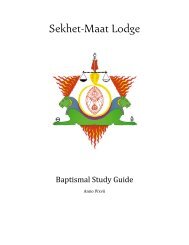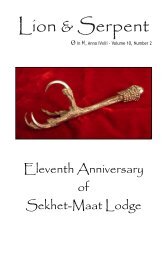Lion & Serpent - Sekhet-Maat Lodge
Lion & Serpent - Sekhet-Maat Lodge
Lion & Serpent - Sekhet-Maat Lodge
You also want an ePaper? Increase the reach of your titles
YUMPU automatically turns print PDFs into web optimized ePapers that Google loves.
16<br />
nomic depression or everyone moves. Even then, with sufficient savings and/or<br />
contingency income, a body may survive the storm.<br />
Aside from practical and strategic considerations, the phrase is, “labor is prayer,”<br />
and the simple meaning of this statement must not be overlooked. It needn’t be<br />
accepted on faith. Quite materialistically, by aaining self-sufficiency through<br />
labor (and those tokens of labor we call “dollars”), a community preserves its<br />
teachings and practices. It is therefore one method of ensuring transmission of the<br />
gnosis. Thereby, labor invokes. This is karma yoga through and through.<br />
If we extend this kind of thinking to our daily life, considering all our efforts and<br />
skills to be of potential benefit to our local bodies, the body’s strength will grow<br />
immeasurably. This strength will also be of benefit to individuals. Consider how<br />
this has benefited the Benedictines:<br />
The great church was the central symbol of faith about which all the<br />
manifold activities of a self-supporting community revolved. The Cistercian<br />
lay-brother was neither a slave nor an anchorite, but a skilled crasman<br />
who wrought in metal, wood and stone, who built roads, wove cloth,<br />
bred stock and planted trees, and who tilled the soil of field and garden to<br />
make barren wastes fruitful. Yet all these manifold and highly individualistic<br />
activities were undertaken, not for personal enrichment, but for the<br />
benefit of the community and as an article of faith which was summed up<br />
in the precept of Stephen Harding: ‘Laborare est Orare’<br />
—High Horse Riderless by L. T. C. Rolt<br />
In the OTO, many of our practices could be considered “monastic,” but we do<br />
not withdraw entirely from the world<br />
into monasteries. Our founding documents<br />
do not recommend monastic<br />
isolation except for temporary<br />
periods. As Magi, standing “upright;<br />
their head above the heavens, their<br />
feet below the hells,” we do not cut<br />
off the lower to exalt the higher. In<br />
these respects, the following passage<br />
As Magi, standing “upright;<br />
their head above the heavens,<br />
their feet below the hells,”<br />
we do not cut off the lower to<br />
exalt the higher.<br />
comparing a development in Zen to the Benedictine ethos is relevant:<br />
One of the main aractions of Zen during the classical period of the<br />
shogunates was its double virtue in reforming monasticism and in its<br />
appeal to the ordinary person engaged in lay life. It did the former by<br />
simplifying monastic life and insisting on both hard labor and the practice<br />
of meditation . . . The movement appealed to the laity because it took seriously<br />
and in a practical way the Mahayana dictum of the identity between<br />
the empirical world or samsara and the transcendental world or nirvana.<br />
It took the idea expressed in the Latin tag laborare est orare, “to work is<br />
to pray,” important for Western monasticism, in new directions, for it integrated<br />
the meditative task and the skills of ordinary life.<br />
—The World’s Religions by Ninian Smart









